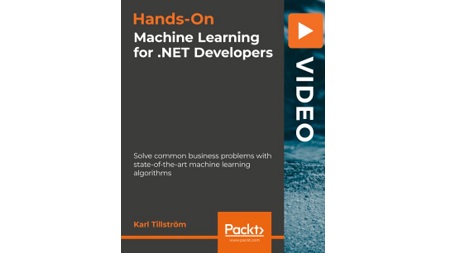
English | MP4 | AVC 1920×1080 | AAC 48KHz 2ch | 2h 47m | 1.65 GB
Use machine learning today without a machine learning background
ML.NET enables developers utilize their .NET skills to easily integrate machine learning into virtually any .NET application. This course will teach you how to implement machine learning and build models using Microsoft’s new Machine Learning library, ML.NET. You will learn how to leverage the library effectively to build and integrate machine learning into your .NET applications.
By taking this course, you will learn how to implement various machine learning tasks and algorithms using the ML.NET library, and use the Model Builder and CLI to build custom models using AutoML.
You will load and prepare data to train and evaluate a model; make predictions with a trained model; and, crucially, retrain it. You will cover image classification, sentiment analysis, recommendation engines, and more! You’ll also work through techniques to improve model performance and accuracy, and extend ML.NET by leveraging pre-trained TensorFlow models using transfer learning in your ML.NET application and some advanced techniques.
By the end of the course, even if you previously lacked existing machine learning knowledge, you will be confident enough to perform machine learning tasks and build custom ML models using the ML.NET library.
What You Will Learn
- Quickly implement machine learning algorithms directly within your current cross-platform .Net applications, such as ASP.Net Web.APIs, desktop applications, and Dotnet core console apps
- Use the advances in machine learning with models customized to your needs
- Automatically evaluate different machine learning models fast using AutoML, Model Builder, and CLI tools
- Improve and retrain your models for better performance and accuracy
- Basic overview of machine learning through a hands-on approach
- Use different machine learning algorithms to solve problems such as sentiment prediction, document classification, image recognition, product recommender systems, price predictions, and Bitcoin price forecasting
- Data loading and preparation for model training
- Leverage state of the art TensorFlow and ONNX models directly in .NET
Table of Contents
Finding the Best Price on Laptops Using Price Prediction (Regression)
1 The Course Overview
2 Demo of the Application and How to Apply Machine Learning
3 Installing the ML.NET Model Builder
4 Automatically Generate a Model with the ML.NET Model Builder
5 Using the Final Model in the Desktop Application
6 Generating the Model Using the ML.NET CLI Tool
Determining Aggression in User Comments
7 Demo of the Web API and the Wikipedia Aggression Dataset
8 Digging into the Code Learn What a Training Pipeline Is
9 Implementing a Pipeline for the Aggression Scorer
10 Using the Custom Model in the Web API
Evaluating, Improving, and Retraining Your Model
11 Evaluating Your Model
12 Splitting the Data into Training and Test Sets
13 Retraining the Model with More Data
14 Evaluating with Cross-Validation
Classifying News into Subjects
15 Multiclass Classification and the UCI News Dataset
16 Using AutoML to Find a Suitable Model
17 Building the Pipeline and Evaluating the Performance
18 Explore the Effect of Imbalanced Data on the Metrics
Building a Recommender System
19 The Restaurant Recommender
20 Building the Restaurant Recommendation Model
21 Exploring Hyper Parameters to Improve the Accuracy
Classifying Images Using TensorFlow ‘Transfer Learning’
22 Image Classification and Our Dataset
23 Deep Learning and Transferring Learnings from TensorFlow
24 Training the Custom Image Classification Model
25 Using the Trained Model in the Desktop Application
26 Speeding Up Model Training Using the GPU
Detecting Facial Expressions in Your Webcam with a Pre-Trained ONNX Model
27 What ONNX Is
28 The FER+ ONNX Model
29 Creating Our ONNX Pipeline
30 Detecting Emotions in Images and Webcam
31 Saving a ML.NET Model in ONNX Format
Resolve the captcha to access the links!